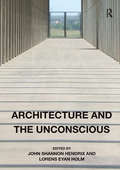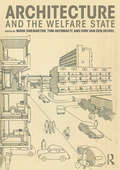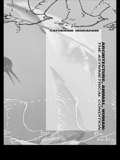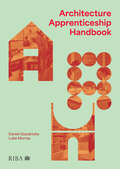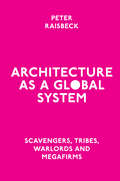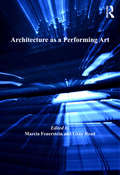- Table View
- List View
Architecture and the Unconscious
by John Shannon Hendrix Lorens Eyan HolmThere are a number of recent texts that draw on psychoanalytic theory as an interpretative approach for understanding architecture, or that use the formal and social logics of architecture for understanding the psyche. But there remains work to be done in bringing what largely amounts to a series of independent voices, into a discourse that is greater than the sum of its parts, in the way that, say, the architect Peter Eisenman was able to do with the architecture of deconstruction or that the historian Manfredo Tafuri was able to do with the Marxist critique of architecture. The discourse of the present volume focuses specifically for the first time on the subject of the unconscious in relation to the design, perception, and understanding of architecture. It brings together an international group of contributors, who provide informed and varied points of view on the role of the unconscious in architectural design and theory and, in doing so, expand architectural theory to unexplored areas, enriching architecture in relation to the humanities. The book explores how architecture engages dreams, desires, imagination, memory, and emotions, how architecture can appeal to a broader scope of human experience and identity. Beginning by examining the historical development of the engagement of the unconscious in architectural discourse, and the current and historical, theoretical and practical, intersections of architecture and psychoanalysis, the volume also analyses the city and the urban condition.
Architecture and the Unconscious
by John Shannon Hendrix Lorens Eyan HolmThere are a number of recent texts that draw on psychoanalytic theory as an interpretative approach for understanding architecture, or that use the formal and social logics of architecture for understanding the psyche. But there remains work to be done in bringing what largely amounts to a series of independent voices, into a discourse that is greater than the sum of its parts, in the way that, say, the architect Peter Eisenman was able to do with the architecture of deconstruction or that the historian Manfredo Tafuri was able to do with the Marxist critique of architecture. The discourse of the present volume focuses specifically for the first time on the subject of the unconscious in relation to the design, perception, and understanding of architecture. It brings together an international group of contributors, who provide informed and varied points of view on the role of the unconscious in architectural design and theory and, in doing so, expand architectural theory to unexplored areas, enriching architecture in relation to the humanities. The book explores how architecture engages dreams, desires, imagination, memory, and emotions, how architecture can appeal to a broader scope of human experience and identity. Beginning by examining the historical development of the engagement of the unconscious in architectural discourse, and the current and historical, theoretical and practical, intersections of architecture and psychoanalysis, the volume also analyses the city and the urban condition.
Architecture and the Welfare State
by Mark Swenarton Tom Avermaete Dirk van den HeuvelIn the decades following World War Two, and in part in response to the Cold War, governments across Western Europe set out ambitious programmes for social welfare and the redistribution of wealth that aimed to improve the everyday lives of their citizens. Many of these welfare state programmes - housing, schools, new towns, cultural and leisure centres – involved not just construction but a new approach to architectural design, in which the welfare objectives of these state-funded programmes were delineated and debated. The impact on architects and architectural design was profound and far-reaching, with welfare state projects moving centre-stage in architectural discourse not just in Europe but worldwide. This is the first book to explore the architecture of the welfare state in Western Europe from an international perspective. With chapters covering Austria, Belgium, France, Germany, Italy, The Netherlands, Sweden and the UK, the book explores the complex role played by architecture in the formation and development of the welfare state in both theory and practice. Themes include: the role of the built environment in the welfare state as a political project the colonial dimension of European welfare state architecture and its ‘export’ to Africa and Asia the role of welfare state projects in promoting consumer culture and economic growth the picture of the collective produced by welfare state architecture the role of architectural innovation in the welfare state the role of the architect, as opposed to construction companies and others, in determining what was built the relationship between architectural and social theory the role of internal institutional critique and the counterculture. Contributors include: Tom Avermaete, Eve Blau, Nicholas Bullock, Miles Glendinning, Janina Gosseye, Hilde Heynen, Caroline Maniaque-Benton, Helena Mattsson, Luca Molinari, Simon Pepper, Michelle Provoost, Lukasz Stanek, Mark Swenarton, Florian Urban and Dirk van den Heuvel.
Architecture and the Welfare State
by Mark Swenarton Tom Avermaete Dirk van den HeuvelIn the decades following World War Two, and in part in response to the Cold War, governments across Western Europe set out ambitious programmes for social welfare and the redistribution of wealth that aimed to improve the everyday lives of their citizens. Many of these welfare state programmes - housing, schools, new towns, cultural and leisure centres – involved not just construction but a new approach to architectural design, in which the welfare objectives of these state-funded programmes were delineated and debated. The impact on architects and architectural design was profound and far-reaching, with welfare state projects moving centre-stage in architectural discourse not just in Europe but worldwide. This is the first book to explore the architecture of the welfare state in Western Europe from an international perspective. With chapters covering Austria, Belgium, France, Germany, Italy, The Netherlands, Sweden and the UK, the book explores the complex role played by architecture in the formation and development of the welfare state in both theory and practice. Themes include: the role of the built environment in the welfare state as a political project the colonial dimension of European welfare state architecture and its ‘export’ to Africa and Asia the role of welfare state projects in promoting consumer culture and economic growth the picture of the collective produced by welfare state architecture the role of architectural innovation in the welfare state the role of the architect, as opposed to construction companies and others, in determining what was built the relationship between architectural and social theory the role of internal institutional critique and the counterculture. Contributors include: Tom Avermaete, Eve Blau, Nicholas Bullock, Miles Glendinning, Janina Gosseye, Hilde Heynen, Caroline Maniaque-Benton, Helena Mattsson, Luca Molinari, Simon Pepper, Michelle Provoost, Lukasz Stanek, Mark Swenarton, Florian Urban and Dirk van den Heuvel.
Architecture And Truth In Fin-de-siècle Vienna (PDF)
by Leslie ToppThis 2004 book examines one of the key notions of modernist architecture as it was formulated in Vienna at the turn of the twentieth century. Providing a close analysis of four major buildings - Olbrich's Secession Building, Hoffmann's Purkersdorf Sanatorium, Wagner's Postal Savings Bank, and Loos's Michaelerplatz building - Leslie Topp investigates how 'truth' could be interpreted in a variety of ways, including truth to purpose, symbolist or ideal truth, and ethical notions of authenticity. Drawing on newly uncovered archival materials, Topp offers an interpretation of familiar buildings that are shown to encompass utopianism, hyper-rationality, and subjectivism. She also explores the connections between Viennese modern architecture and contemporary painting, psychiatry, fashion, labor issues, and anti-Semitic politics.
Architecture and Ugliness: Anti-Aesthetics and the Ugly in Postmodern Architecture
by Wouter Van Acker Thomas MicalWhatever 'ugliness' is, it remains a problematic category in architectural aesthetics - alternately vilified and appropriated, either to shock or to invert conventions of architecture.This book presents eighteen new essays which rethink ugliness in architecture - from brutalism to eclectic postmodern architectural productions - and together offer a diverse reappraisal of the history and theory of postmodern architecture and design. The essays address both broad theoretical questions on ugliness and postmodern aesthetics, as well as more specific analyses of significant architectural examples dating from the last decades of the twentieth century, addressing the relation between the aesthetic register of ugliness and aesthetic concepts such as brutalism, kitsch, the formless, ad hoc-ism, the monstrous, or the grotesque.The aim of this volume is not simply to document the history of a postmodern anti-aesthetic through case studies. Instead, it aims to shed light on an aesthetic problem that has been largely overlooked in the agenda of architectural theory, the question if and how ugliness can be of interest to architecture; or if and how architecture can make good use of ugliness.
Architecture and Ugliness: Anti-Aesthetics and the Ugly in Postmodern Architecture
by Wouter Van Acker Thomas MicalWhatever 'ugliness' is, it remains a problematic category in architectural aesthetics - alternately vilified and appropriated, either to shock or to invert conventions of architecture.This book presents eighteen new essays which rethink ugliness in architecture - from brutalism to eclectic postmodern architectural productions - and together offer a diverse reappraisal of the history and theory of postmodern architecture and design. The essays address both broad theoretical questions on ugliness and postmodern aesthetics, as well as more specific analyses of significant architectural examples dating from the last decades of the twentieth century, addressing the relation between the aesthetic register of ugliness and aesthetic concepts such as brutalism, kitsch, the formless, ad hoc-ism, the monstrous, or the grotesque.The aim of this volume is not simply to document the history of a postmodern anti-aesthetic through case studies. Instead, it aims to shed light on an aesthetic problem that has been largely overlooked in the agenda of architectural theory, the question if and how ugliness can be of interest to architecture; or if and how architecture can make good use of ugliness.
Architecture and Urban Form in Kuala Lumpur: Race and Chinese Spaces in a Postcolonial City
by Yat Ming LooKuala Lumpur, the capital city of Malaysia, is a former colony of the British Empire which today prides itself in being a multicultural society par excellence. However, the Islamisation of the urban landscape, which is at the core of Malaysia’s decolonisation projects, has marginalised the Chinese urban spaces which were once at the heart of Kuala Lumpur. Engaging with complex colonial and postcolonial aspects of the city, from the British colonial era in the 1880s to the modernisation period in the 1990s, this book demonstrates how Kuala Lumpur’s urban landscape is overwritten by a racial agenda through the promotion of Malaysian Architecture, including the world-famous mega-projects of the Petronas Twin Towers and the new administrative capital of Putrajaya. Drawing on a wide range of Chinese community archives, interviews and resources, the book illustrates how Kuala Lumpur’s Chinese spaces have been subjugated. This includes original case studies showing how the Chinese re-appropriated the Kuala Lumpur old city centre of Chinatown and Chinese cemeteries as a way of contesting state’s hegemonic national identity and ideology. This book is arguably the first academic book to examine the relationship of Malaysia’s large Chinese minority with the politics of architecture and urbanism in Kuala Lumpur. It is also one of the few academic books to situate the Chinese diaspora spaces at the centre of the construction of city and nation. By including the spatial contestation of those from the margins and their resistance against the state ideology, this book proposes a recuperative urban and architectural history, seeking to revalidate the marginalised spaces of minority community and re-script them into the narrative of the postcolonial nation-state.
Architecture and Urban Form in Kuala Lumpur: Race and Chinese Spaces in a Postcolonial City
by Yat Ming LooKuala Lumpur, the capital city of Malaysia, is a former colony of the British Empire which today prides itself in being a multicultural society par excellence. However, the Islamisation of the urban landscape, which is at the core of Malaysia’s decolonisation projects, has marginalised the Chinese urban spaces which were once at the heart of Kuala Lumpur. Engaging with complex colonial and postcolonial aspects of the city, from the British colonial era in the 1880s to the modernisation period in the 1990s, this book demonstrates how Kuala Lumpur’s urban landscape is overwritten by a racial agenda through the promotion of Malaysian Architecture, including the world-famous mega-projects of the Petronas Twin Towers and the new administrative capital of Putrajaya. Drawing on a wide range of Chinese community archives, interviews and resources, the book illustrates how Kuala Lumpur’s Chinese spaces have been subjugated. This includes original case studies showing how the Chinese re-appropriated the Kuala Lumpur old city centre of Chinatown and Chinese cemeteries as a way of contesting state’s hegemonic national identity and ideology. This book is arguably the first academic book to examine the relationship of Malaysia’s large Chinese minority with the politics of architecture and urbanism in Kuala Lumpur. It is also one of the few academic books to situate the Chinese diaspora spaces at the centre of the construction of city and nation. By including the spatial contestation of those from the margins and their resistance against the state ideology, this book proposes a recuperative urban and architectural history, seeking to revalidate the marginalised spaces of minority community and re-script them into the narrative of the postcolonial nation-state.
Architecture and Urban Transformation of Historical Markets: Cases from the Middle East and North Africa (Architecture and Urbanism in the Global South)
by Neveen HamzaThis book explores the complex relationship between societies, architecture, and urbanism of market halls, traditional souqs, bazaars, and speciality street markets in the Middle East and North Africa. It addresses how these trading environments influence perceptions of place and play an extended social, political, and religious role while adapting to their local climates. Through Archival research and social science methodologies, this book records and maps markets in urban fabrics, expanding on practices underlying the push towards historical listings and the development of markets as landmarks in the urban fabric. The role of markets in delivering sustainable place-making strategies and influencing the development of cities’ socio-economic and historical strength is addressed as key to their survival in the urban fabric and as place-making landmarks for preserving tangible and intangible heritage. Going beyond heritage and conservation studies, this book discusses how positioning and restoring markets challenges urban renewal policies, access to public space planning, environmental sustainability, security of food supply, cultural heritage, and tourism. This is an ideal read for those interested in the history of urban development, architecture and urban planning, and architectural heritage.
Architecture and Urban Transformation of Historical Markets: Cases from the Middle East and North Africa (Architecture and Urbanism in the Global South)
by Neveen HamzaThis book explores the complex relationship between societies, architecture, and urbanism of market halls, traditional souqs, bazaars, and speciality street markets in the Middle East and North Africa. It addresses how these trading environments influence perceptions of place and play an extended social, political, and religious role while adapting to their local climates. Through Archival research and social science methodologies, this book records and maps markets in urban fabrics, expanding on practices underlying the push towards historical listings and the development of markets as landmarks in the urban fabric. The role of markets in delivering sustainable place-making strategies and influencing the development of cities’ socio-economic and historical strength is addressed as key to their survival in the urban fabric and as place-making landmarks for preserving tangible and intangible heritage. Going beyond heritage and conservation studies, this book discusses how positioning and restoring markets challenges urban renewal policies, access to public space planning, environmental sustainability, security of food supply, cultural heritage, and tourism. This is an ideal read for those interested in the history of urban development, architecture and urban planning, and architectural heritage.
Architecture and Urbanism in a Contact Zone: Histories of Difference, Migrancy and Dwelling in Kolkata (Architecture and Urbanism in the Global South)
by Mark Mukherjee CampbellThis book explores how histories of migration, cultural encounter and transculturation have shaped formations of urban space, domestic architecture and cultural modernity in Kolkata from the early colonial period to the beginning of the era of India’s economic liberalization. It charts how these themes were manifest in what was an important ‘contact zone’ in the history of globalization and the modern city. Drawing on a wide range of resources and representations, from urban plans and architectural drawings to European travel journals and Bengali literature and cinema, the book investigates the history of Kolkata through an examination of key urban and architectural spaces across the colonial and postcolonial epochs. Through illustrated chapters, it sheds new light on questions of difference and segregation, cultural hybridity, migration, and entanglements of tradition and modernity in the city, analyzing spaces inhabited by a diverse range of cultures, including several neglected in previous studies. Architecture and Urbanism in a Contact Zone offers an instructive contribution to the fields of global architectural history and theory, urban studies and postcolonial cultural studies for scholars, researchers and students alike.
Architecture and Urbanism in a Contact Zone: Histories of Difference, Migrancy and Dwelling in Kolkata (Architecture and Urbanism in the Global South)
by Mark Mukherjee CampbellThis book explores how histories of migration, cultural encounter and transculturation have shaped formations of urban space, domestic architecture and cultural modernity in Kolkata from the early colonial period to the beginning of the era of India’s economic liberalization. It charts how these themes were manifest in what was an important ‘contact zone’ in the history of globalization and the modern city. Drawing on a wide range of resources and representations, from urban plans and architectural drawings to European travel journals and Bengali literature and cinema, the book investigates the history of Kolkata through an examination of key urban and architectural spaces across the colonial and postcolonial epochs. Through illustrated chapters, it sheds new light on questions of difference and segregation, cultural hybridity, migration, and entanglements of tradition and modernity in the city, analyzing spaces inhabited by a diverse range of cultures, including several neglected in previous studies. Architecture and Urbanism in a Contact Zone offers an instructive contribution to the fields of global architectural history and theory, urban studies and postcolonial cultural studies for scholars, researchers and students alike.
Architecture and Urbanism in Viceregal Mexico: Puebla de los Ángeles, Sixteenth to Eighteenth Centuries (Routledge Research in Architectural History)
by Juan Luis BurkeArchitecture and Urbanism in Viceregal Mexico presents a fascinating survey of urban history between the sixteenth and eighteenth centuries. It chronicles the creation and development of Puebla de los Ángeles, a city located in central-south Mexico, during its viceregal period. Founded in 1531, the city was established as a Spanish settlement surrounded by important Indigenous towns. This situation prompted a colonial city that developed along Spanish colonial guidelines but became influenced by the native communities that settled in it, creating one of the most architecturally rich cities in colonial Spanish America, from the Renaissance to the Baroque periods. This book covers the city's historical background, investigating its civic and religious institutions as represented in selected architectural landmarks. Throughout the narrative, Burke weaves together sociological, anthropological, and historical analysis to discuss the city’s architectural and urban development. Written for academics, students, and researchers interested in architectural history, Latin American studies, and the Spanish American viceregal period, it will make an important contribution to the field.
Architecture and Urbanism in Viceregal Mexico: Puebla de los Ángeles, Sixteenth to Eighteenth Centuries (Routledge Research in Architectural History)
by Juan Luis BurkeArchitecture and Urbanism in Viceregal Mexico presents a fascinating survey of urban history between the sixteenth and eighteenth centuries. It chronicles the creation and development of Puebla de los Ángeles, a city located in central-south Mexico, during its viceregal period. Founded in 1531, the city was established as a Spanish settlement surrounded by important Indigenous towns. This situation prompted a colonial city that developed along Spanish colonial guidelines but became influenced by the native communities that settled in it, creating one of the most architecturally rich cities in colonial Spanish America, from the Renaissance to the Baroque periods. This book covers the city's historical background, investigating its civic and religious institutions as represented in selected architectural landmarks. Throughout the narrative, Burke weaves together sociological, anthropological, and historical analysis to discuss the city’s architectural and urban development. Written for academics, students, and researchers interested in architectural history, Latin American studies, and the Spanish American viceregal period, it will make an important contribution to the field.
Architecture and Utopia: The Israeli Experiment (Design and the Built Environment)
by Michael ChyutinThere are more than 450 Moshavim settlements and about 270 kibbutzim in Israel. While there is a range of communal and cooperative kibbutz movements, all with slight ideological differences, they are all collective rural communities, based on an ideal to create a social utopian settlement. Placing the kibbutz within the wider context of utopian social ideals and how they have historically been physically and architecturally constructed, this book discusses the form of the 'ideal settlement' as an integral part and means for realizing a utopian doctrine. It presents an analysis of physical planning in the kibbutz through the past eight decades and how changes in ideology are reflected in changes in layout and aesthetics. In doing so, this book shows how a utopian settlement organization behaves over time, from their first appearance in 1920 on, to an examination of the current spatial layouts and the directions of their expected future development.
Architecture and Utopia: The Israeli Experiment (Design and the Built Environment)
by Michael ChyutinThere are more than 450 Moshavim settlements and about 270 kibbutzim in Israel. While there is a range of communal and cooperative kibbutz movements, all with slight ideological differences, they are all collective rural communities, based on an ideal to create a social utopian settlement. Placing the kibbutz within the wider context of utopian social ideals and how they have historically been physically and architecturally constructed, this book discusses the form of the 'ideal settlement' as an integral part and means for realizing a utopian doctrine. It presents an analysis of physical planning in the kibbutz through the past eight decades and how changes in ideology are reflected in changes in layout and aesthetics. In doing so, this book shows how a utopian settlement organization behaves over time, from their first appearance in 1920 on, to an examination of the current spatial layouts and the directions of their expected future development.
Architecture, Animal, Human: The Asymmetrical Condition
by Catherine T. IngrahamThis book looks at specific instances in the Renaissance, Enlightenment and our own time when architectural ideas and ideas of biological life come into close proximity with each other. These convergences are fascinating and complex, offering new insights into architecture and its role. Establishing architecture as a product of the ascendancy of the position of human life, the author shows here that while architecture is dependent on life forces for its existence, at the same time it must be, at some level, indifferent to the life within it. Life, for its part, privileges itself above all else, and seeks to continuously expand its field of expression. This, then, is the asymmetrical condition, and to understand it is to gain important new theoretical perspectives into the nature of architecture.
Architecture, Animal, Human: The Asymmetrical Condition
by Catherine T. IngrahamThis book looks at specific instances in the Renaissance, Enlightenment and our own time when architectural ideas and ideas of biological life come into close proximity with each other. These convergences are fascinating and complex, offering new insights into architecture and its role. Establishing architecture as a product of the ascendancy of the position of human life, the author shows here that while architecture is dependent on life forces for its existence, at the same time it must be, at some level, indifferent to the life within it. Life, for its part, privileges itself above all else, and seeks to continuously expand its field of expression. This, then, is the asymmetrical condition, and to understand it is to gain important new theoretical perspectives into the nature of architecture.
Architecture Apprenticeship Handbook
by Daniel Goodricke Luke MurrayArchitecture apprenticeships are a new route into the profession. Having gained traction since their inception in 2018, it is an attractive route for young generations of architects to obtain their professional qualifications and earn while they learn. Aimed at prospective and current Level 7: Architect Apprentices, this guide provides the knowledge to achieve the most from your apprenticeship education, empowering your exposure in the profession within academic and professional areas. Taking you on a journey through the apprenticeship, it presents key stages of the course through precedents and will let you know what to expect from this educational route, and when to expect it. Using case studies from recent graduates and current apprentices who have excelled through this route, it features information from employers and academics involved in architecture apprenticeship courses in the UK to provide tips, advice and guidance. Designed to be interactive, you will be able to populate and annotate the book at various stages to map the key stages of your journey and reflect on your professional development.
Architecture Apprenticeship Handbook
by Daniel Goodricke Luke MurrayArchitecture apprenticeships are a new route into the profession. Having gained traction since their inception in 2018, it is an attractive route for young generations of architects to obtain their professional qualifications and earn while they learn. Aimed at prospective and current Level 7: Architect Apprentices, this guide provides the knowledge to achieve the most from your apprenticeship education, empowering your exposure in the profession within academic and professional areas. Taking you on a journey through the apprenticeship, it presents key stages of the course through precedents and will let you know what to expect from this educational route, and when to expect it. Using case studies from recent graduates and current apprentices who have excelled through this route, it features information from employers and academics involved in architecture apprenticeship courses in the UK to provide tips, advice and guidance. Designed to be interactive, you will be able to populate and annotate the book at various stages to map the key stages of your journey and reflect on your professional development.
Architecture as a Global System: Scavengers, Tribes, Warlords and Megafirms
by Peter RaisbeckSince the 1980s the architectural profession across the world has been driven by globalisation. The factors shaping this globalisation include neo-liberal economics, digital transformation and the rise of social media against the background of the profession’s entrenched labour practices. In describing architecture as a global system, this book outlines how globalisation has shaped architecture and explores the degree to which architecture remains a distinct field of knowledge. The book identifies four categories of architects in this global system: scavengers, tribes, warlords and megafirms. By employing this institutional-logics approach, the author looks beyond the surface spectacle of iconic projects, celebrity architects and cycles of urban focused media outrage. From this perspective, the book illuminates the archipelagos and outposts of disciplinary knowledge that architectural actors traverse and highlights the frontiers at which architectural knowledge is both created and eroded. The author argues that to retain their future agency, architects must understand the contours and ecologies of practice that constitute this global system of architectural production. This book provides a clear-sighted analysis to suggest the points that need reconfiguring in this global system so that architects may yet shape and order the future of cities.
Architecture as a Global System: Scavengers, Tribes, Warlords and Megafirms
by Peter RaisbeckSince the 1980s the architectural profession across the world has been driven by globalisation. The factors shaping this globalisation include neo-liberal economics, digital transformation and the rise of social media against the background of the profession’s entrenched labour practices. In describing architecture as a global system, this book outlines how globalisation has shaped architecture and explores the degree to which architecture remains a distinct field of knowledge. The book identifies four categories of architects in this global system: scavengers, tribes, warlords and megafirms. By employing this institutional-logics approach, the author looks beyond the surface spectacle of iconic projects, celebrity architects and cycles of urban focused media outrage. From this perspective, the book illuminates the archipelagos and outposts of disciplinary knowledge that architectural actors traverse and highlights the frontiers at which architectural knowledge is both created and eroded. The author argues that to retain their future agency, architects must understand the contours and ecologies of practice that constitute this global system of architectural production. This book provides a clear-sighted analysis to suggest the points that need reconfiguring in this global system so that architects may yet shape and order the future of cities.
Architecture as a Performing Art
by Marcia Feuerstein Gray ReadHow do buildings act with people and among people in the performances of life? This collection of essays reveals a deep alliance between architecture and the performing arts, uncovering its roots in ancient stories, and tracing a continuous tradition of thought that emerges in contemporary practice. With fresh insight, the authors ask how buildings perform with people as partners, rather than how they look as formal compositions. They focus on actions: the door that offers the possibility of making a dramatic entrance, the window that frames a scene, and the city street that is transformed in carnival. The essays also consider the design process as a performance improvised among many players and offer examples of recent practice that integrates theater and dance. This collection advances architectural theory, history, and criticism by proposing the lens of performance as a way to engage the multiple roles that buildings can play, without reducing them to functional categories. By casting architecture as spatial action rather than as static form, these essays open a promising avenue for future investigation. For architects, the essays propose integrating performance into design through playful explorations that can reveal intense relationships between people and place, and among people in place. Such practices develop an architectural imagination that intuitively asks, 'How might people play out their stories in this place?' and 'How might this place spark new stories?' Questions such as these reside in the heart of all of the essays presented here. Together, they open a position in the intersection between everyday life and staged performance to rethink the role of architectural design.
Architecture as a Performing Art
by Marcia Feuerstein Gray ReadHow do buildings act with people and among people in the performances of life? This collection of essays reveals a deep alliance between architecture and the performing arts, uncovering its roots in ancient stories, and tracing a continuous tradition of thought that emerges in contemporary practice. With fresh insight, the authors ask how buildings perform with people as partners, rather than how they look as formal compositions. They focus on actions: the door that offers the possibility of making a dramatic entrance, the window that frames a scene, and the city street that is transformed in carnival. The essays also consider the design process as a performance improvised among many players and offer examples of recent practice that integrates theater and dance. This collection advances architectural theory, history, and criticism by proposing the lens of performance as a way to engage the multiple roles that buildings can play, without reducing them to functional categories. By casting architecture as spatial action rather than as static form, these essays open a promising avenue for future investigation. For architects, the essays propose integrating performance into design through playful explorations that can reveal intense relationships between people and place, and among people in place. Such practices develop an architectural imagination that intuitively asks, 'How might people play out their stories in this place?' and 'How might this place spark new stories?' Questions such as these reside in the heart of all of the essays presented here. Together, they open a position in the intersection between everyday life and staged performance to rethink the role of architectural design.
